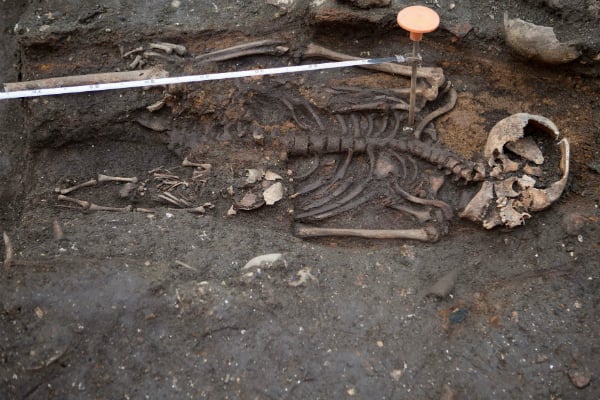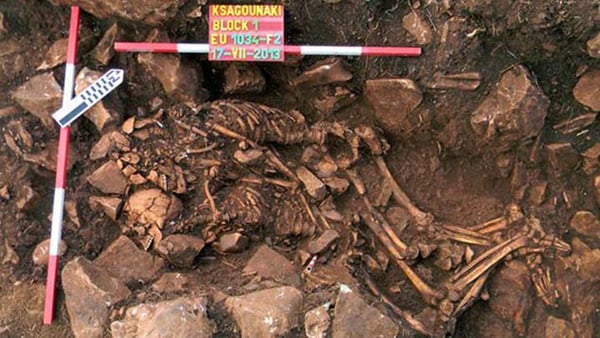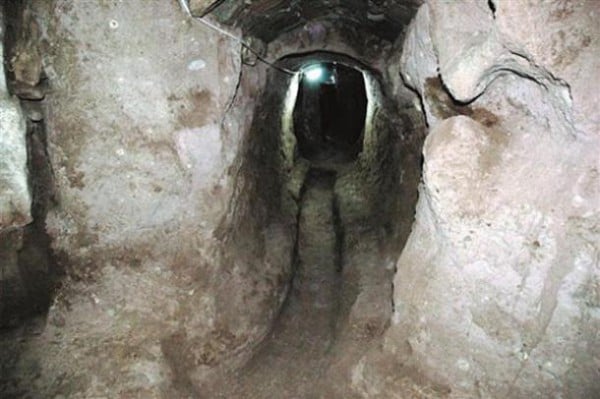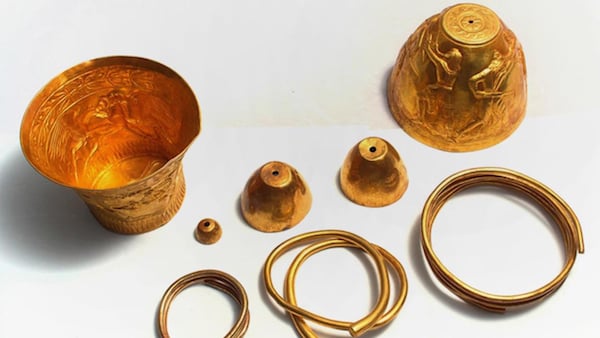Art World
See the Weirdest Archaeological Discoveries of Recent Times
Is there no end to the strangeness of the past?

Is there no end to the strangeness of the past?

Amah-Rose Abrams

Humanity is around 200,000 years old, and although you could be forgiven for forgetting this, occasionally a discovery is made that reminds us all of just how long us humans have been around.
Whether by accident or design, it seems there is no limit on the strangeness of what can be dug up out of the ground when it comes to the human race.
We have compiled a list of the oddest, most hedonistic, and endearing archaeological discoveries unearthed in recent times.

An adult and a baby skeleton lay uncovered at the Bedlam burial ground in London.
Londoners have—predictably—been grumbling about the Crossrail, the redesign of the city’s transport system, since it was announced. Adding to their ire, the works involved deep digging, and are revealing so many archaeological sites under the historic city that the company has recruited an archaeologist, and the project is subject to constant delays.
The largest of these was burial a ground containing a whopping 3,000 skeletons near Liverpool Street Station in the City of London. The Bedlam Burial Ground, used between 1569 and 1738, was singled out for those who could not afford, or did not want, a church burial.
Scientists hope the remains will give them insight into the Black Death plague, which swept through England in the 14th century.
“This excavation presents a unique opportunity to understand the lives and deaths of 16th and 17th century Londoners,” said Crossrail’s lead archaeologist Jay Carver. “The Bedlam burial ground spans a fascinating phase of London’s history, including the transition from the Tudor-period City into cosmopolitan early-modern London.”

Archaeologists in Greece discovered a rare burial of a prehistoric couple positioned in an embrace.
Photo: Courtesy Greek Culture Ministry
Last year, the prehistoric skeletons of a couple entwined in a deathly embrace were romantically discovered just in time for Valentine’s Day.
The remains of the man and woman spooning each other were found in the cave of Diros, in the Peloponnese peninsular, southern Greece.
“Double burials in embrace are extremely rare, and that of Diros is one of the oldest in the world, if not the oldest found to this date,” said the Greek Culture Ministry of the find.
According to the scientists, the crypt, which also contained other bodies and artifacts, dates from around 3,000 BC.

Part of the tunnel system that links an underground city discovered in Turkey.
When Mustafa Bozdemir of Anatolia, Turkey, decided to dig under his single story home to create space, the last thing he was expecting to find was an ancient city.
“We thought that there might be storage space for food or a stable beneath the house,” he told Zaman Online. “But [I] had no idea that it was part of an underground city. The underground city that we found by accident during restoration begins a few meters under the ground and has two levels. There are parts resembling underground remains of settlements in Cappadocia. Wonderful structures emerged everywhere, like an iron workshop and a loft,” he added.
When digging down, workmen discovered a rock cut entrance to a tunnel. Since then, several floors of living space, covering approximately 4,000 square meters (43,000 square feet), have been excavated.
“The underground city was active in the Roman, Byzantine, and Seljuk eras and other stone buildings there were built in the Ottoman and Republican periods,” local mayor Mehmet Osmanbasogl declared.
Bozdemir hopes to turn the unique site into a tourist attraction.

The Littlemore Priory Pub is the only building that remains of a convent that once stood on the site. Photo via Wikimedia Commons.
Perhaps the most scandalous discovery in recent years has been the discovery of a burial ground of at least 35 disgraced nuns near Oxford, in the UK.
The nuns had belonged to a nunnery—which opened in 1110—that was run by an infamous prioress, Katherine Wells, who had nuns sleeping two to a bed and also had a child with a local priest. Sir Thomas Wolsey, moral arbitrator of the time and adviser to King Henry VIII, shut the unconventional establishment down in 1542.
Some of the bodies were buried upside down, a “mark of shame” according to the puritanical moral practices of the time. So-called “prone burials” are thought to have been reserved for witches or sinners.
Believed to be 600 to 900 years old, the bodies of the “sinner nuns” were discovered near Oxford United football stadium, and next to a hotel. The site contained 92 skeletons in total, of which 28 were believed to be male. In 29 cases it was impossible to determine a gender.

The items have now been cleaned and put on display in a museum.
Did you know that the ancient warriors of the Scythians, a nomadic Iranian tribe, ritually smoked narcotics before going into battle?
In June of this year, archaeologists in Southern Russia discovered a number of 2,400 year-old pure gold “bongs,” which still contained traces of marijuana and opium.
The battle preparation techniques of the Scythians were legendary, with Greek philosopher Herodotus waxing lyrical on the effects.”Scythians used a plant to produce smoke that no Grecian vapor-bath can surpass which made them shout aloud,” he wrote of the wild warrior tribe.